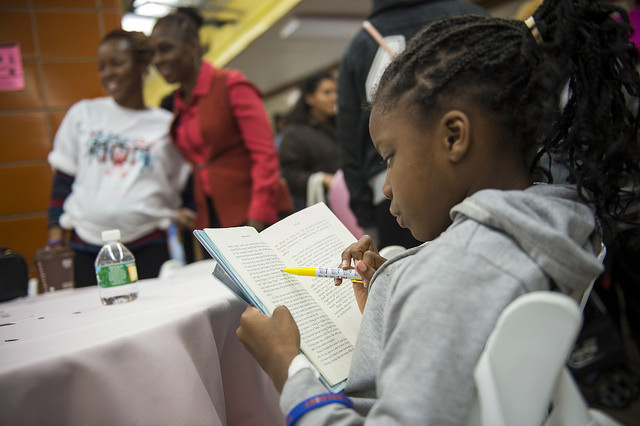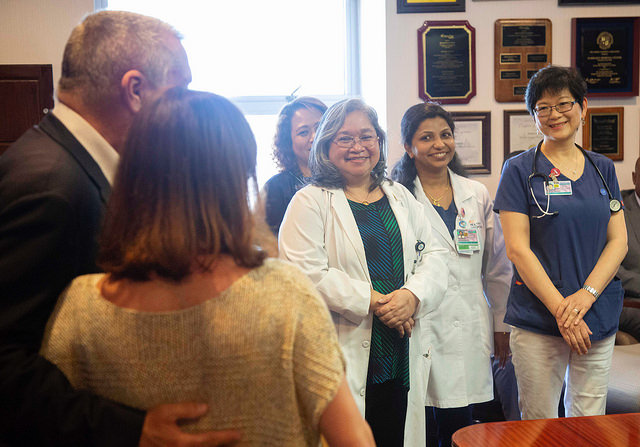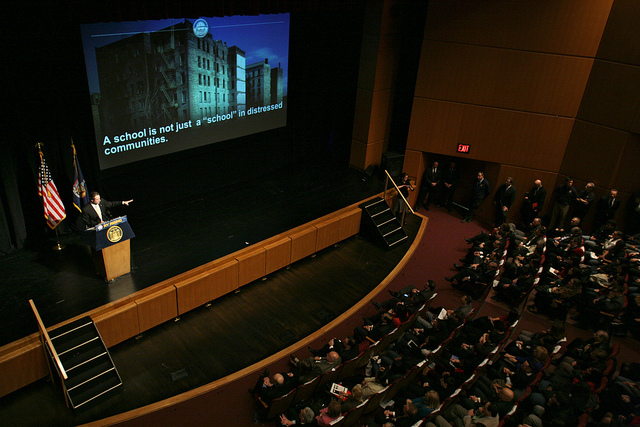The Answer to More Diversity at Specialized High Schools is Tutoring Programs Like Ours

(photo: Ed Reed/Mayor's Office)
Last week, 27,000 eighth-graders and their parents opened exam results, hoping they had won a coveted seat at one of New York City’s eight specialized high schools. Unsurprisingly, this year’s offers followed trends of past years, with only 10.5 percent of offers going to black and Hispanic students, who comprise 68 percent of the overall public school system. At Stuyvesant High School, a mere seven black students and 33 Hispanic students were offered one of the 895 seats.
These disparities have long prompted debate about how to create more racial and ethnic equity in the specialized high schools while maintaining their quality. Although the test is open to all, few students in lower-income areas are able to afford test preparation, or even know about the exam. Those who do sit for it often can’t compete due to subpar educations in their poor neighborhoods.
Mayor de Blasio wants to abandon the test in favor of holistic assessments based on student grades, test scores, and class rankings. Over the course of a three-year phase-out of the test, his plan would have the number of students admitted based on class rank increase incrementally until 90 percent of offers go to the top 7 percent of students at each middle school. The remaining 10 percent of seats would be subject to a lottery open only to those with a minimum grade average of 93 percent. During the transition period, the Discovery Program, which offers admittance to low-income students who just missed the cutoff score on completion of a summer enrichment program, would expand to 20 percent of all seats.
Although diversity should be paramount to admissions, I fear that Mayor de Blasio’s proposal trades systems of exclusivity. In order to evaluate students based strictly on their scores, the test doesn’t compensate for inequities in early education. By contrast, assessments based on class rankings ignore the merit of individuals below the 7 percent line to overcompensate for inequities. Without the test, however, the student bodies of specialized high schools may be no different than others because the plan places unequal middle schools on an equal playing field.
Moreover, students’ abilities set the pace in classrooms and determine the quality of discussions. An undistinguished student body removes the challenges meant to be integral to a specialized high school education.
Rather than reform the system to the advantage of all New Yorkers, Mayor de Blasio proposes to lower the bar. The substandard education that students of color often receive will remain in place in elementary and middle schools. Programs designed to prepare students for the entrance exam will disappear, and with them the enrichment opportunities offered to students regardless of the results.
The diversity problem I’ve witnessed firsthand at the High School of American Studies at Lehman College, a specialized high school in the Bronx where I’m a junior, persists. Some of my classmates are first-generation immigrants who overcame the disadvantage of a non-English speaking or low-income household to gain a seat. They’re the exception. In fact, they’re often among a handful of students at their middle school to be admitted to a specialized high school. In contrast, the graduating class of my Upper West Side middle school received 150 offers from specialized high schools. I had a scholarship to a tutoring program for the test, but this isn’t an option for most students of color.
Recognizing this lack of resources, a new student-run tutoring program was created at my high school to prepare local Bronx middle school students for the SHSAT. A team of upperclassmen create and teach English and math lessons twice weekly to a class of seventh-graders. We plan activities, explain the high school process to ensure that the middle school students see admittance to our school as attainable, and provide snacks.
But teenagers can only tutor 30 kids at a time when thousands more deserve enrichment opportunities. All specialized high schools and other schools should host tutoring programs. These programs can and should reach more students and at a younger age, so that fairness and diversity are ensured long before incoming students walk through the door.
***
Jade Lozada is a junior at the High School of American Studies at Lehman College and a second-generation Hispanic American. Through a student-run tutoring program, she teaches local Bronx middle-schoolers English Language Arts in preparation for the SHSAT exam.
***
Have an op-ed idea or submission for Gotham Gazette? Email This email address is being protected from spambots. You need JavaScript enabled to view it.
Crafting a State Budget to Enhance Nurse-Family Partnership and Support Vulnerable New York Families

(photo: John McCarten/NY City Council)
We live in a state with enormous resources, and a $175 billion annual budget—yet many New Yorkers still lack access to adequate maternal care. New York's maternal mortality rate is higher than the national average, and even worse in communities of color. Black women are over three times more likely to die from complications during childbirth than their white counterparts.
All too often, the outcome of a woman's pregnancy has less to do with her health than with the quality of care she receives over the course of those nine months. For many women across our state, poverty and a lack of resources can be the decisive factor in determining the outcome of a pregnancy. That's unacceptable. We need better services and a standardized level of care to ensure that all women, regardless of their income level, race, or geography, can experience a safe and healthy delivery.
It’s time for New York to get serious about these issues, and address these startling trends. That’s why I pushed for the New York State Senate to increase funding in our chamber’s state budget plan for maternal health care – and why I’m now calling for that funding to remain in the final budget, to be agreed on by the Governor and the Legislature by April 1.
With expanded funding, we can better support the essential work being done through New York’s Nurse-Family Partnership programs. These programs, located throughout New York City and the state, connect the most high-risk first-time mothers in poverty with their own personal registered nurse through pregnancy and the baby’s first 1,000 days.
These nurses provide more than home visits to assess mom’s health and baby’s development; they offer social support and guidance on many critical facets of a woman’s life. They connect new moms with services to help find stable employment and housing, resources to make ends meet, like local food banks, and healthcare services during pregnancy and beyond. Their visits set the stage for a lifetime of healthy development. In fact, the program has seen significant improvement in pregnancy outcomes, including a reduction in preterm births and healthier pregnancies in New York state.
As the proud parent of two young daughters, I know how important it is that we support families through pregnancy and early childhood. And as a policymaker, I believe that New York has a responsibility to ensure that every family has access to the care they need.
Furthermore, every dollar invested in Nurse-Family Partnership yields $5.70 in return to government. Additional funds will guarantee the program can operate at its current level and potentially reach more vulnerable New Yorkers—something all of my colleagues should support. Investing in future generations isn't just the moral thing to do, it’s smart public policy.
***
State Senator Brad Hoylman represents parts of Manhattan. On Twitter @bradhoylman.
***
Have an op-ed idea or submission for Gotham Gazette? Email This email address is being protected from spambots. You need JavaScript enabled to view it.
State Leaders Must Follow Through on Their Promise of a More Fair New York

(photo: Governor's office)
As we near the final days of state budget negotiations, a familiar anxiety is growing as advocacy groups and everyday New Yorkers await the fate of critical policy and funding decisions.
Despite a fast start to the legislative session and optimism abounding from a Democratic trifecta that seemed focused and committed to delivering on campaign promises, the realities of the same-old behind-closed-doors budget process are setting in ahead of the April 1 deadline.
For far too long, the state budget has contributed to growing inequality and deteriorating services across the state. While state budgets tread water or move us backwards, the continuing “strength” of the economy has further tipped to the wealthiest among us.
The recently re-elected Governor and newly-elected members of the Assembly and the Senate ran on the promise to chart a new course.
Make no mistake: It is THAT vision of a fairer, cleaner, kinder, and more equitable New York that helped take down the Independent Democratic Conference, strengthen the Democratic majority in the Assembly, and elect 39 Democratic Senators for a new majority that voted to put Senator Andrea Stewart-Cousins into her rightful place as the leader of the Senate.
Grassroots organizations like ours, Empire State Indivisible, have spent the first three months of 2019 in the streets organizing in support of that vision. But strangely it’s now many of these same elected officials who are pushing back against the fight for fairness and democracy.
Exhibit A: the continued resistance from many members of the Assembly to finally pass through both houses legislation for publicly-funded elections.
For years, the Assembly championed this issue: 88 current members are on the record for past support. Yet, now that there’s a viable path to passage, many of those former champions now claim there are too many open questions.
Grassroots organizers across the state have reported consistent questioning from many of their electeds like “how would the program be implemented?”, “what would be the model of oversight?”, and “where would the funds come from?”
It turns out these reasonable questions already have incredibly thoughtful and effective answers. Organizations like Citizen Action and the Brennan Center for Justice have been bending over backwards to work with the conferences in the Senate and the Assembly to answer the questions and make the legislation as effective as possible. It’s disingenuous to claim that last-minute questions are the reason support for the measure is lacking.
The fact is that our elected officials are sent to Albany to solve complicated problems with conviction.
They are the ones responsible to design policies that solve the challenges New York faces. The irony of elected officials refusing to participate in the process of crafting the details of policy they claim to support is lost on no one.
Exhibit B: skittishness among many lawmakers on establishing fair tax and fiscal policies.
Governor Cuomo’s budget proposals consistently create a battle for funds amongst the most critical services. His penchant for “horse trading” (as many insiders refer to it) pits public school funding against healthcare spending, support of clean energy and municipal infrastructure projects against investments in affordable housing, and so on and so on.
We and many other New Yorkers have been asking legislators about increasing revenue through new fair-share tax proposals like the “ultra millionaires tax,” which extends the current millionaires tax and adds brackets for people whose annual income exceeds $5million, $10 million, and $100 million.
Too often, the answers have been truly dismissive and patronizing -- particularly from the new Senate majority and the Governor. The pushback is a status-quo run-around: lawmakers fear that raising taxes -- even on multimillionaires and billionaires who got huge new tax breaks from President Trump -- might cause them to lose elections in 2020.
The numbers and the polling suggests otherwise.
Insisting that the ultra-rich pay their fair share of a burden that has for too long been shouldered by the poor, the middle class, and the upper middle class will in fact be answering to the will of the people. It will allow all the members of the Democratic majorities in both the Assembly and the Senate and the Governor to deliver on the promises that galvanized voters to elect such a strong slate of Democrats in the first place -- and will inspire us to do so again.
The ask is simple: No more excuses. We simply can’t afford them.
***
Ricky Silver is co-lead organizer of Empire State Indivisible. On Twitter @es_indivisible.
***
Have an op-ed idea or submission for Gotham Gazette? Email This email address is being protected from spambots. You need JavaScript enabled to view it.




